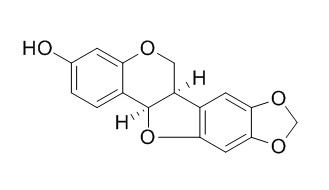Maackiain
Maackiain is an antimicrobial compound (phytoalexins), it has anticancer effects, it induces apoptosis and growth suppression. Maackiain also shows strong larvicidal activity (LC50 = 21.95 ± 1.34 ug/mL).
Inquire / Order:
manager@chemfaces.com
Technical Inquiries:
service@chemfaces.com
Tel:
+86-27-84237783
Fax:
+86-27-84254680
Address:
1 Building, No. 83, CheCheng Rd., Wuhan Economic and Technological Development Zone, Wuhan, Hubei 430056, PRC
Providing storage is as stated on the product vial and the vial is kept tightly sealed, the product can be stored for up to
24 months(2-8C).
Wherever possible, you should prepare and use solutions on the same day. However, if you need to make up stock solutions in advance, we recommend that you store the solution as aliquots in tightly sealed vials at -20C. Generally, these will be useable for up to two weeks. Before use, and prior to opening the vial we recommend that you allow your product to equilibrate to room temperature for at least 1 hour.
Need more advice on solubility, usage and handling? Please email to: service@chemfaces.com
The packaging of the product may have turned upside down during transportation, resulting in the natural compounds adhering to the neck or cap of the vial. take the vial out of its packaging and gently shake to let the compounds fall to the bottom of the vial. for liquid products, centrifuge at 200-500 RPM to gather the liquid at the bottom of the vial. try to avoid loss or contamination during handling.
Eur J Pharmacol.2020, 889:173589.
Front Pharmacol.2020, 11:683.
Int J Anal Chem.2017, 2017:1254721
The Korea Journal of Herbology2020, 35(3):33-45.
Journal of Ginseng Research2023, 12.004.
Cell Commun Signal.2024, 22(1):597.
Prev Nutr Food Sci.2024, 29(4):563-571.
JEJU National University2022, 24032.
Phytother Res.2019, 33(4):1104-1113
Pharmacognosy Magazine2017, 13(52):868-874
Related and Featured Products
Exp Parasitol. 2015 Jun;153:160-4.
Extract of Bowdichia virgilioides and maackiain as larvicidal agent against Aedes aegypti mosquito.[Pubmed:
25819294]
METHODS AND RESULTS:
The larvicidal activities of extracts of three hardwood species (Hymenaea stigonorcapa, Anadenanthera colubrina and Bowdichia virgilioides) against 4th instar larvae of Aedes aegypti were evaluated using WHO guidelines.
Extracts of H. stignocarpa and A. colubrina showed weak activity. The highest larvicidal effect was obtained with the cyclohexane extract of the heartwood of B. virgilioides, which caused 100% mortality at concentrations at 50 and 100 µg/mL. Fraction toluene/EtOAc (8:2) from this extract showed larvicidal activity (LC₅₀ = 34.90 ± 1.27 µg/mL). A mixture of two compounds identified as medicarpin and Maackiain exhibited a very good larvicidal activity (sub-fraction 2, LC₅₀ = 17.5 ± 1.87 µg/mL) and Maackiain showed to be a strong larvicidal compound (LC₅₀ = 21.95 ± 1.34 µg/mL).
CONCLUSIONS:
This result can be of value in the search for new natural larvicidal compounds from other hardwood plant extracts and presents the first report of B. virgilioides being used to control a mosquito vector.
Oncol Rep. 2004 Dec;12(6):1183-8.
Induction of apoptosis by maackiain and trifolirhizin (maackiain glycoside) isolated from sanzukon (Sophora Subprostrate Chen et T. Chen) in human promyelotic leukemia HL-60 cells.[Pubmed:
15547735]
METHODS AND RESULTS:
We have investigated the effects of Maackiain and trifolirhizin (Maackiain glycoside) isolated from sanzukon (Sophora Subprostrate Chen et T. Chen) on DNA of human promyelotic HL-60 leukemia cells. It was found that extent of induction of apoptosis by Maackiain was larger than that by trifolirhizin in human leukemia HL-60 cells. Morphological changes showing apoptotic bodies were observed in the HL-60 cells treated with Maackiain and trifolirhizin. The fragmentations of DNA by Maackiain and trifolirhizin to oligonucleosomal-sized fragments that is a characteristic of apoptosis was observed to be concentration- and time-dependent in the HL-60 cells.
CONCLUSIONS:
The data of the present study show that the suppressions by Maackiain and trifolrhizin of growth of the HL-60 cells result from the induction of apoptosis by these compounds, and that the extent of growth suppression and induction of apoptosis by Maackiain was greater than that by the glycoside (trifolirhizin).
Appl Environ Microbiol. 1992 Mar;58(3):801-8.
Three Genes for Metabolism of the Phytoalexin Maackiain in the Plant Pathogen Nectria haematococca: Meiotic Instability and Relationship to a New Gene for Pisatin Demethylase.[Pubmed:
16348671 ]
Some isolates of the plant-pathogenic fungus Nectria haematococca mating population (MP) VI metabolize Maackiain and medicarpin, two antimicrobial compounds (phytoalexins) synthesized by chickpea (Cicer arietinum L.). The enzymatic modifications by the fungus convert the phytoalexins to less toxic derivatives, and this detoxification has been proposed to be important for pathogenesis on chickpea.
METHODS AND RESULTS:
In the present study, loci controlling Maackiain metabolism (Mak genes) were identified by crosses among isolates of N. haematococca MP VI that differed in their ability to metabolize the phytoalexin. Strains carrying Mak1 or Mak2 converted Maackiain to 1a-hydroxyMaackiain, while those with Mak3 converted it to 6a-hydroxyMaackiain. Mak1 and Mak2 were unusual in that they often failed to be inherited by progeny. Mak1 was closely linked to Pda6, a new member in a family of genes in N. haematococca MP VI that encode enzymes for detoxification of pisatin, the phytoalexin synthesized by garden pea. Like Mak1, Pda6 was also transmitted irregularly to progeny.
CONCLUSIONS:
Although the unusual meiotic behaviors of some Mak genes complicate genetic analysis, identification of these genes should afford a more through evaluation of the role of phytoalexin detoxification in the pathogenesis of N. haematococca MP VI on chickpea.



